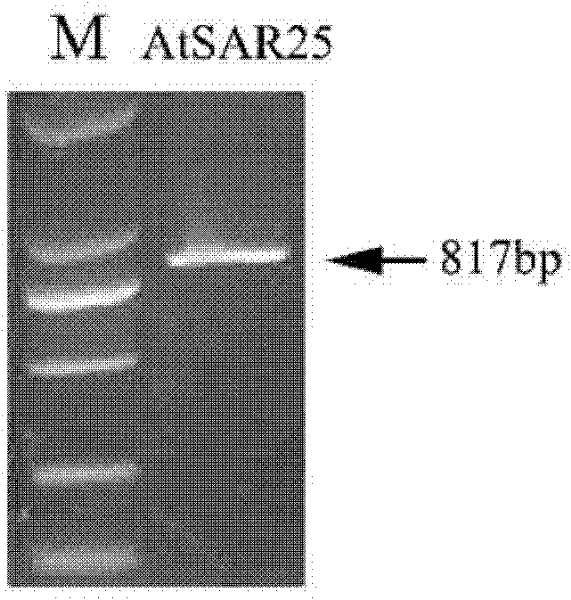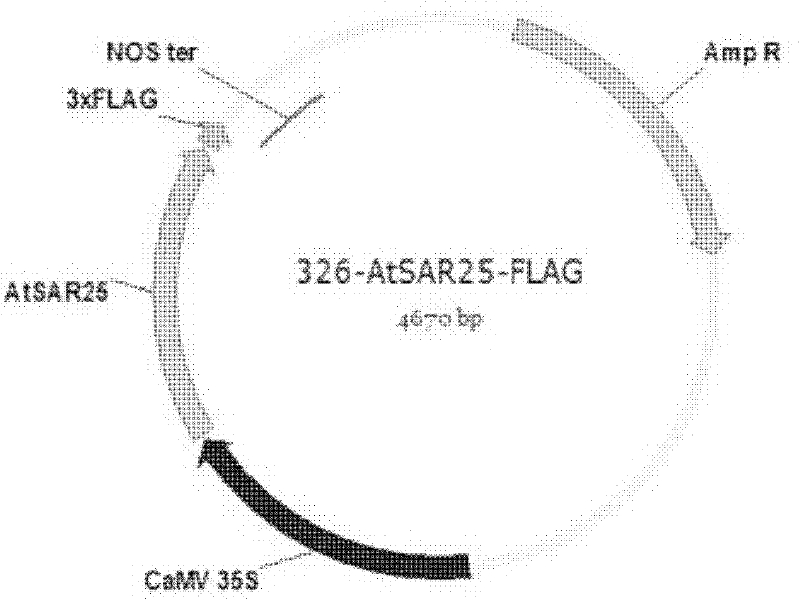Plant resistance related protein ATSAR 25, and encoding genes and application thereof
A gene and encoding technology, applied in the field of plant resistance-related protein ATSAR25 and its encoding gene and application, can solve the problems of polluted environment and high cost, and achieve the effect of enhancing disease resistance
- Summary
- Abstract
- Description
- Claims
- Application Information
AI Technical Summary
Problems solved by technology
Method used
Image
Examples
Embodiment 1
[0047] Embodiment 1, the acquisition of ATSAR25 protein and its coding gene
[0048] 1. According to the existing NCBI database and literature, set a pair of primers as follows:
[0049] F1 (forward primer): 5'-GC TCTAGA GCAAAATAAGAAATTCTATAAGTCCT-3' (XbaI digestion recognition sequence is underlined);
[0050] R1 (reverse primer): 5'-CG GGATCC gatgtctctcaagatctgcca-3' (underlined BamHI restriction recognition sequence).
[0051] 2. Genomic DNA was extracted from leaves of Arabidopsis thaliana ecotype Columbia.
[0052] 3. Using genomic DNA as a template, use the primer pair designed in step 1, and perform PCR amplification with PrimeSTAR HS high-fidelity enzyme from TaKaRa Company.
[0053] 4. The PCR amplification product is sequenced, as shown in sequence 2 of the sequence listing.
[0054] The protein shown in Sequence 1 of the sequence listing is named ATSAR25 protein. The gene encoding the ATSAR25 protein is named as the ATSAR25 gene, and its genomic DNA is shown...
Embodiment 2
[0055] Embodiment 2, the cloning of each gene and the construction of its recombinant expression vector
[0056] 1. Acquisition of ATSAR25 gene and construction of recombinant plasmid 326-ATSAR25-FLAG
[0057] 1. Genomic DNA was extracted from leaves of Arabidopsis thaliana ecotype Columbia.
[0058] 2. Using the genomic DNA in step 1 as a template, use the primer pair composed of F1 and R1 to carry out PCR amplification under the action of TaKaRa's PrimeSTAR HS high-fidelity enzyme to obtain PCR amplification products. The agarose gel electrophoresis of the PCR amplification product is shown in figure 1 (M represents a nucleotide marker, which is DL2000 from TaKaRa Company).
[0059] 3. The PCR amplification product of step 2 was double-digested with restriction enzymes XbaI and BamHI, and the digested product was recovered.
[0060] 4. The 326-FLAG expression vector was double digested with restriction enzymes XbaI and BamHI, and the vector backbone of about 3827 bp was r...
Embodiment 3
[0073] Embodiment 3, ATSAR25 gene is inducing PR1 gene promoter (Pro AtPR1 ) application in promoting gene expression
[0074] 1. Transient expression of recombinant plasmids in Arabidopsis leaf protoplasts
[0075] The recombinant plasmid 326-ATSAR25-FLAG and recombinant plasmid 326-Pro constructed in Example 2 AtPR1 ::GFP co-transformed Arabidopsis protoplasts (recombinant plasmid 326-T 7 -FLC is used as a negative control of the recombinant plasmid 326-ATSAR25-FLAG; the 326-FLAG expression vector is used as another negative control of the recombinant plasmid 326-ATSAR25-FLAG), the specific steps are as follows:
[0076] 1. Germinate Colombian ecotype Arabidopsis seeds on MS medium, transplant them into soil when the roots grow to 1-3 cm, and cultivate them in a greenhouse at 23° C. (12 hours of light per day, light intensity of 150 μE).
[0077] 2. Add 20ml of double distilled water to a 90mm petri dish, then add 1.82g of D-mannitol and dissolve it.
[0078] 3. Take the...
PUM
 Login to View More
Login to View More Abstract
Description
Claims
Application Information
 Login to View More
Login to View More - R&D
- Intellectual Property
- Life Sciences
- Materials
- Tech Scout
- Unparalleled Data Quality
- Higher Quality Content
- 60% Fewer Hallucinations
Browse by: Latest US Patents, China's latest patents, Technical Efficacy Thesaurus, Application Domain, Technology Topic, Popular Technical Reports.
© 2025 PatSnap. All rights reserved.Legal|Privacy policy|Modern Slavery Act Transparency Statement|Sitemap|About US| Contact US: help@patsnap.com



